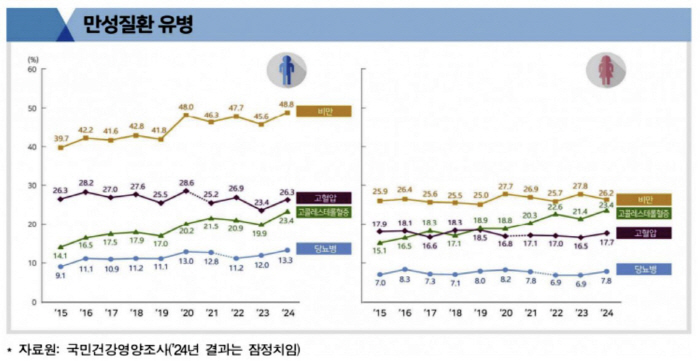Men climb, women fall...the prevalence of obesity
Sep 30, 2025
|
According to the results of the "2024 National Health and Nutrition Survey" released by the Korea Centers for Disease Control and Prevention on the 30th, the proportion of hypertension, diabetes, and hypercholesterolemia (hypercholesterolemia), one of the three major adult diseases, was higher in both men and women last year than a year ago. The survey was conducted by screening, interviewing, and self-writing about 10,000 household members aged 1 or older in 2,800 households in 192 regions nationwide.
The prevalence of hypertension (the proportion of people with diseases) among adults over the age of 19 was 26.3% for men and 17.7% for women last year, up 2.9 percentage points and 1.2 percentage points from a year ago, respectively.
The prevalence of diabetes was 10.6%, exceeding 10% in three years after 10.3% in 2021. The prevalence of hyperlipidemia rose 3.5 percentage points and 2.0 percentage points to 13.3 percent for men and 7.8 percent for women, respectively, while the prevalence of hyperlipidemia rose 3.5 percentage points and 2.0 percentage points, respectively, to 23.4 percent for both men and women.
In particular, for men, the prevalence of obesity (body mass index of 25 or more) increased by 3.2 percentage points to 48.8%. On the other hand, the prevalence of obesity among women decreased by 1.6 percentage points to 26.2%.
About half of men in their 30s and 50s were obese, especially in their 40s (50.2% → 61.7%), the prevalence of obesity increased (11.5 percentage points) compared to the previous year. The prevalence of obesity among men in their 30s and 50s fell by 1.3 percentage points and 1.8 percentage points to 49.1% and 48.1%, respectively. The prevalence of major chronic diseases in men in their 40s increased. Hypertension was 27.8% (+4.3 percentage points), diabetes was 13.7% (+2.4 percentage points), and hyperlipidemia was 27.5% (+5.0 percentage points).
However, management indicators were found to have improved. The recognition rate, treatment rate, and control rate of chronic diseases have improved, especially among those in their 30s and 40s, and the management index of hypertension and diabetes has improved significantly.
For women, the prevalence of obesity in their 70s and older was 38.3%, 33.5% in their 60s, 27.9% in their 50s, 25.7% in their 40s, 24.6% in their 30s, and 20.4% in their 20s.
In terms of nutritional intake compared to the previous year, both men and women's meat intake increased and fruit intake decreased. Meat intake increased 5.7% year-on-year to 134.7g, especially in men in their 30s and 50s. Fruit intake was 110.5g, down 5.8 percentage points from the previous year. In addition, grain intake (252g) and vegetable intake (232.3g) decreased by 0.2 percentage points compared to the previous year, respectively. Beverage intake also increased 1.8 percentage points to 276.4g during the same period.
Energy intake was also 1865 ㎉, similar to the previous year.However, the proportion of fat continued to increase, and the rate of energy intake through fat for men in their 30s was 30.2%, which was the upper limit of the appropriate rate (30%). The fat energy intake fraction was 26.8%, the carbohydrate energy intake fraction was 57%, the protein energy intake fraction was 16.3%, the sodium intake was 3075.2 mg, and the sugar intake was 57.4 g.
Meanwhile, the breakfast skipping rate was 35.3%, up 0.7 percentage points from the previous year, and up 9.1 percentage points from 2015. In particular, 67.5% of women aged 19 to 29 skipped breakfast.
This article was translated by Naver AI translator.














